In an age when potential buyers regularly research reviews and testimonials of products and services as part of the purchasing process, customer evangelists have become an essential part of partners' sales and marketing efforts.
To build the kind of loyalty that motivates customers to spend time on reference calls, case study interviews and event appearances, Microsoft takes a continuous approach to nurturing those relationships. Without making a big investment, partners can build their own league of customer evangelists, willing to devote time to sharing their story with prospects.
"When you are trying to make your number every quarter, you need customers to help you send home the message," says Kimberly Gordon, director of Microsoft's U.S. customer reference and advocate program. "I used to sell and understand the importance of the reference call."
To be able to support those reference calls on their own, partners need to develop long-term, two-way relationships. In a project-driven industry, many partners built their businesses on short-term customer engagement: Make the sale, implement the project and move on to the next one. Nurturing customers may not be part of their company DNA.
"Forging those long-term relationships with customers is really just about letting them know that you care," Gordon said. "It starts with things like quickly getting them through any deployment issues and always calling them back within 24 hours. Nurturing begins with the very first project and never stops."
One of the best things about nurturing clients is that is doesn't require deep pockets. Gordon says that many of the Microsoft strategies to reward customer advocates cost nothing but time -- for example, connecting the customer to specialized resources when they need help on a project, providing a quote for the customer's press release, or featuring the customer story in a national publication.
One of the most popular "thank you's" sponsored by Gordon's team has been an executive breakfast held every year at Microsoft's now-discontinued Convergence conference. The breakfast gave customers who had served as references an opportunity to interact directly with Microsoft executives, industry analysts and peers. "Our goal was to simply to show the customers how much we appreciate their time without asking for anything," said Gordon.
Without a big investment, partners can implement a similar customer advocacy reward program. Actively and continuously showing appreciation for customers smooths the way when you need a favor. A few ideas to get you going include:
- Tweet or blog about customer achievements.
- Ask customers to speak at your next event, providing them with exposure to a local audience.
- Sponsor a quarterly networking event or executive briefing for clients at a craft brewery.
- Make proactive calls to check in on customers.
A programmatic effort to consistently engage with your customers will pay off in additional business, as well as provide a steady source of references.
"At the end of the day, you don't want to ignore existing customers. Don't just go back when it's time to renew a contract or get idle people off the bench," said Gordon. "Make customers feel valued with the small things that you do over time. Provide that value add and take your relationship one step further."
How do you build long-term customer relationships? Add a comment below or send me an e-mail and let's share the knowledge.
Posted by Barb Levisay on May 05, 20160 comments
You've been putting it off for too long. You know your Web site needs an update -- especially if it's not mobile-friendly -- but its redesign keeps going to the bottom of the list.
Summer is just around the corner, and with a slower pace of business, it's a great time for a Web site makeover. To inspire you to make the commitment, we found some partners who are setting the pace with stand-out Web sites.
1. Palmetto Technology Group, an Office 365 partner, has a history of staying ahead of the marketing curve. Its Web site has a clean design with photographs of real people. It's mobile-friendly, offers lots of content and makes it easy for a visitor to make contact.
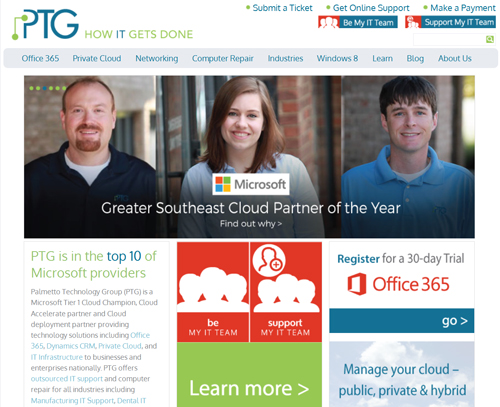
2. Clean design and limited text make the Web site of system integrator RBA Consulting immediately engaging. No big words, no clichés and leading with customer stories set a non-tech tone that is likely to appeal to business decision makers. The customer stories are a refreshing break from the problem/solution/benefits case study drudgery.
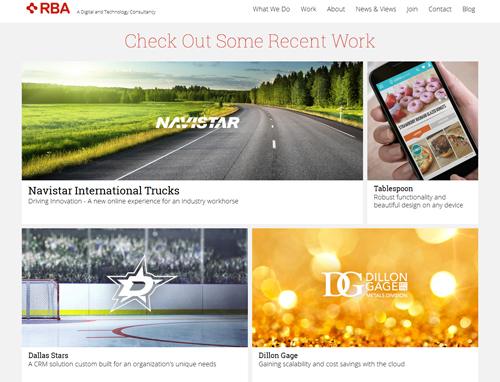
3. The home page of eMazzanti Technologies, an SMB partner, gets straight to the point with a description of who it helps and what services it delivers. It offers content in a variety of forms, including blog posts and videos, on the home page. It's nice to see a sense of humor at the bottom of the main page with some IT Ninjas. We need more of that in the channel.
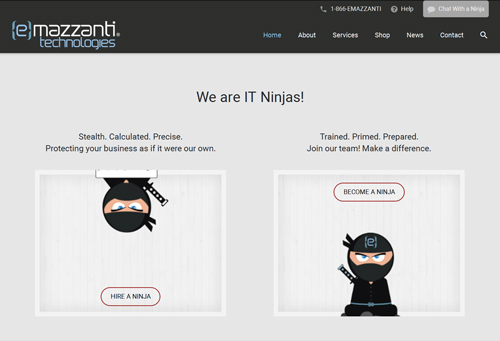
4. Sonoma Partners cuts to the chase, as well, with very efficient use of words. It handles the challenge of establishing credibility for multiple industry specialties especially well. On the home page, in just a couple of sentences, Sonoma Partners conveys its industry knowledge in three different vertical markets.
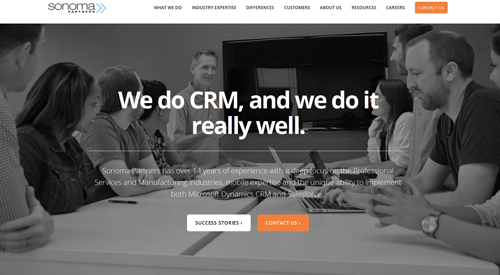
5. For those partners who want to take their vertical marketing a step further, justfoodERP is an example of an industry-specific site done right. In addition to effective use of bold graphics, the site is full of educational content and customer stories. The live-chat pop-up is a nice touch.
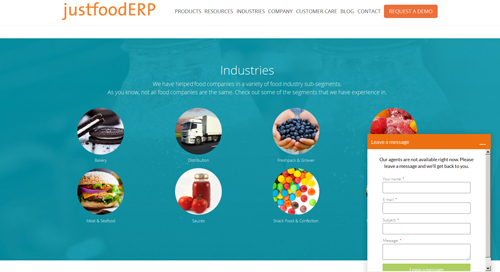
6. The strength of Alligatortek's Web site comes through its focus on customers. With an entire section dedicated to client relationships, the custom development partner sends a strong message on its top priority.
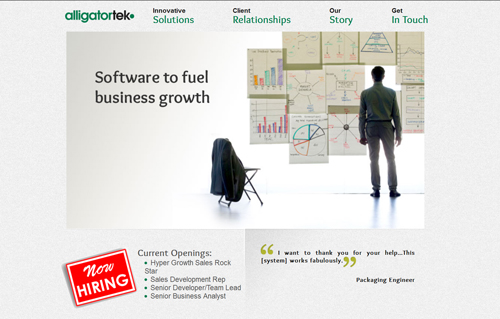
7. Tidestone Solutions, a Dynamics ERP partner, makes a personal connection with readers by labeling its site sections "Your Industry" and "Your Current Software" -- a subtle but effective detail. Tidestone appears to be perfectly comfortable showing the size of its team and making introductions to its consulting team. Targeting those companies looking for personal, caring service, it makes a strong case.
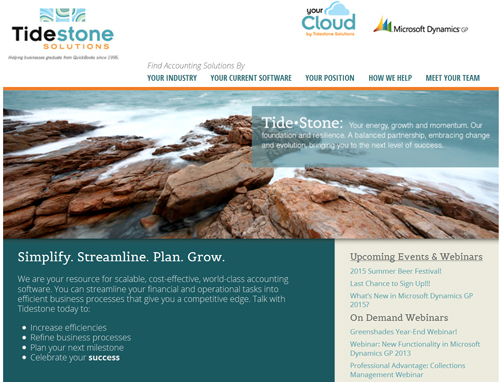
8. Designing a Web site to connect with partners effectively is a challenge for every ISV. Business Intelligence ISV Solver has clearly given a lot of thought to that challenge. The partner overview page defines the options without clutter, directing visitors down the right path without confusing them.
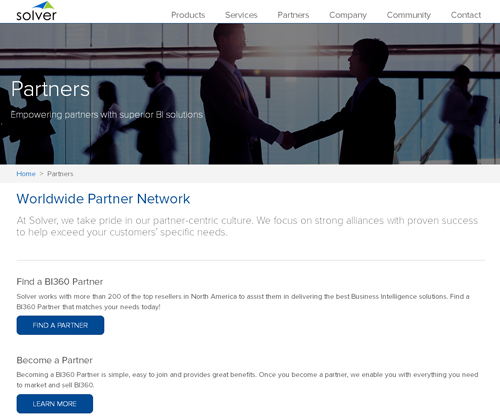
These are just a few examples of the many partners doing a great job with their online presence. Your site doesn't need to be state-of-the-art -- just informative and engaging (and work across devices). Now that you have some fresh inspiration, it's time to get started.
Have a Web site success story? Add a comment below or send me a note and let's share the knowledge.
Posted by Barb Levisay on March 16, 20160 comments
Creating a newsletter every month may not seem like a tough assignment...until it's yours. In the beginning, everyone has lots of great ideas to share. Consultants promise project stories from the field. The support team will supply a steady flow of tips and tricks. Management looks forward to sharing their leadership and best-practice advice. All the ingredients for a read-worthy newsletter.
Then they get busy. And you're on your own.
Newsletters Build Customer-Lifetime Value
Newsletters may be the most important marketing activity to support partners' cloud business models. More dependence on subscription-based relationships means that building customer-lifetime value should be a primary focus of the marketing team. Monthly newsletters may not be sexy, but they are the workhorse of ongoing customer engagement.
Creating a monthly newsletter that customers will actually open and read is daunting indeed. Their inboxes are stuffed and their attention is short. But you do have some advantages -- they know you and they view your organization as an expert source. Build on those strengths and throw in a dash of personality.
A few ideas to inspire:
- Be the Microsoft filter. The amount of information Microsoft creates each month is staggering. Help your customers sort through it by summarizing a couple of top stories and providing a link. The Fire Hose is a good central source to monitor.
- Multi-part customer success stories. Your clients are interested in hearing about businesses like theirs. They want to hear about common challenges and how other businesses dealt with them. While most case studies are boring and lifeless, they don't need to be. Give some background and tell the story in real words, describing the challenges and the solutions. By writing the story in "chapters," you can keep installments short for readability and, if done well, a reason for clients to tune in next month. (It sure worked for The Martian.)
- Top problem solved this month. Dealing with real customer problems every day, your help desk should be a rich source of material. They may not have the time or inclination to write something up for you, but you can interview them. Ask clarifying questions to translate the issues into common terms that non-technical readers will understand.
- Use Microsoft marketing resources as a foundation. The content that Microsoft makes available through Ready-to-Go marketing has dramatically improved over the past couple of years. There are templates and artwork you can use to make your newsletter look more professional. Use the content, like campaign materials, as a base, then add examples and commentary to make it your own.
- Office diversions. A little fun can go a long way. Something as simple as a monthly cartoon can entice your readers to open the newsletter. A subscription to a business cartoon service is a low-cost way to show customers you have a sense of humor.
- Ask your customers. While it's tempting to send out a survey asking what your clients would like to see in the newsletter, you're not likely to get much input. Instead, ask them in person at your next event or call them on the phone.
Coming up with interesting content isn't as hard as you think. Stand in your customers' shoes and write about the business issues that they deal with every day. Don't worry about being a great writer; practice is the only way to get better. Outsourcing is an option, but an outside writer won't reflect the personality of your team.
A good newsletter provides an incredible marketing value to your organization. It takes time. It takes commitment. And your customers will appreciate both of those.
How are you engaging with customers to build lifetime value? Add a comment below or send me a note and let's share the knowledge.
Posted by Barb Levisay on March 02, 20160 comments
Delivering on the promise to provide more support for developers and ISVs, the Microsoft Go-To-Market Services Web site has an impressive collection of sales and marketing resources. Almost any type of partner, especially SIs and VARs who are formalizing intellectual property for the Cloud Solution Provider (CSP) program, will find the site's templates and planning tools valuable.
The site includes four groups of resources -- "Attract Customers," "Engage Users," "Accelerate Growth" and "Expand Partnerships" -- plus a Concierge Desk. The Concierge Desk promises one-on-one consultation to help you make the most of the resources.
Attract Customers
There are a number of programs to help with online marketing, from search advertising to Microsoft Office store listings. According to the success stories posted on the site, these programs are delivering real results for partners. To help you focus in on the services that could help you the most, guidance from the Concierge Desk may be the best place to start.
Also, in the Attract Customers section is a co-branded event in a box. The templates are very heavy on Azure, so you will want to adjust the message to focus on the benefits of your solution. While association with Microsoft will help build confidence in your brand, your prospects are most interested in the value that your solution brings to their business. When you are planning an event, consider asking one or two of your current clients to speak.
Engage Users
Every Microsoft partner should download and use the Sales Accelerator Toolkit. There are two parts to the toolkit -- a "Value Prop" e-book and "Demand Gen" e-book.
- The Value Prop e-book includes customer surveys, a competitive analysis template and a positioning framework to help focus your messaging and better connect with your prospects. The guides are practical and easy to follow.
- For many partners, just knowing where to start with marketing is the biggest barrier. The Demand Gen e-book and templates provide a great starting point for you to take a systematic approach to marketing.
The mini-case study and datasheet templates will help you create professional-looking support documents. Use plain English and specific examples of the benefits that your clients have received. For the case study, use statistics if your customer can provide them. "Our salespeople now close 25 percent more of their sales on the first call" is far more powerful than generalities.
Accelerate Growth
The Accelerate Growth section leads to a number of the other Microsoft partner and ISV support sites. The ISV and Application Builder Site has become a major hub with Microsoft's renewed focus on ISVs.
Expand Partnerships
This section also leads to Microsoft Partner Network (MPN) resources like Worldwide Partner Conference (WPC) and the community blog. Additional resources to consider are the MPN Yammer groups and the International Association of Microsoft Channel Partners (IAMCP), which is an active professional association with chapters around the world.
Case Studies
There are dozens of short partner case studies under the "Success Stories" tab, which suggests that lots of ISVs have discovered and are using the services of the Go-To-Market site. Great to see partners taking advantage of Microsoft's efforts.
While the Microsoft Go-To-Market Services Web site may be intended for the ISV and developer communities, there are marketing resources that every type of partner should be using. A visit to the site is well worth the time.
How are you using the ISV Go-To-Market resources? Add a comment below or send me a note and let's share the knowledge.
Posted by Barb Levisay on February 17, 20160 comments
With social media hogging the marketing spotlight over the past couple of years, one would think that e-mail was a relic of the past. Apparently not. The Harvard Business Review reports that e-mail is making a "triumphant resurgence." HubSpot's recent Digital Publishing Benchmarks Report found that 34.3 percent of B2B marketers are still using e-mail to drive revenue.
The good news is that the mechanics of sending out and tracking e-mail newsletters have gotten much easier over the years. But there is still that little detail of creating content month in and month out. And not just any content, but meaningful content that your prospects and customers will be interested in reading.
To help you overcome that perpetual challenge, we've assembled some resources you can tap.
First Stop: Microsoft Ready-to-Go
Microsoft's Ready-to-Go (RtG) marketing site has become a goldmine of content and education for partners. Go beyond the e-mail templates to find the building blocks for newsletter content. A few ideas to quickly create a compelling article:
- Summarize a campaign whitepaper, linking to the document through a landing page on your Web site.
- Use the notes in the sales presentations, which are written in a conversational tone, to create an informative article that addresses a common business problem. There are often interesting statistics in sales presentations that make a good call-out.
- Tap into the growing number of videos on RtG to deliver content for all customer preferences.
- Use the telesales guides as a source for good benefit and persona-driven text that you can expand into an article.
ISV- and Vendor-Supplied Content
Trading partners are an often-overlooked source of content. Ask the ISVs and other vendors that you work with to help you create content. They may have a stock of pre-written articles or be willing to commit to an article each quarter.
Local and Regional Business Partners
If you serve a regional market, your local Chamber of Commerce or technology council will appreciate promotion of their events. Invite a non-competing business that serves the same market to contribute a regular article. By consolidating local business information, you add value to your newsletter and provide a good reason for people to sign up.
Industry Influencer for Vertical Markets
If you are targeting a vertical market, consider teaming up with an industry influencer. An article from the industry expert, especially one who is active on social media, can build your standing and readership.
Customer Frequently Asked Questions
If you don't already have one, work with your consulting and support team to develop a list of your customers' frequently asked questions and responses. Include one or two in every issue of the newsletter.
Recycle Blog Posts
If your organization has (or had) a blog, there are probably older articles that could be spruced up to be just as relevant today as when they were written. Content is the gift that keeps on giving -- a little polish and that blog post will shine again.
Content Curation
Through content curation, you monitor information and bring the best to the attention of your prospects. When you find an article worth sharing, provide a summary of the article, add commentary and link to the full text. By helping to filter and uncover valuable content, you save time for your prospects and build your status as an industry expert.
A newsletter can be a powerful marketing tool, but it's very challenging for most partners to create read-worthy content every month. Tapping into the resources of vendors, partners and your own consulting team can ease the burden. Providing valuable information to your prospects and customers every month establishes your business as an expert and keeps your name fresh in their minds.
How are you engaging customers and prospects through your newsletter? Add a comment below or send me an e-mail and let's share the knowledge.
Posted by Barb Levisay on December 15, 20150 comments
For most partners, marketing the packaged services of Microsoft's Cloud Solution Provider (CSP) program is uncharted territory. Packaged services force a change in messaging from software to business value -- a welcome but challenging transition for most technology marketers. The business problem that the packaged service solves, instead of the technology behind it, has to drive the messaging and the marketing.
As you start to build the marketing plans that will support your CSP offerings, Microsoft's Cloud Profitability Scenarios should be the first stop. Under the ModernBiz campaign at the bottom of the page, the Partner Value Propositions do an excellent job explaining how cloud technologies plus partner services combine to deliver the full value to customers. These docs should be required reading for everyone on your sales and marketing teams.
Then, follow these five steps to create your own value propositions and build the marketing campaigns that deliver a clear, benefit-driven message to your targeted audience.
1. Spend Time with Consultants To Understand Services
Ideally, the marketing team will be closely involved in defining the CSP offerings, identifying target markets and value propositions. At the very least, marketers need to understand -- in very real terms -- the services that you provide through the packaged services. While that may seem obvious, there are too many marketers who have never visited a client or listened in on support calls. Effective messaging can only be created by people who can stand in the shoes of your prospect.
2. Build on Resources that Microsoft Is Providing
Microsoft has upped its game in providing marketing resources to partners. If you're not taking advantage of them, you're missing out on a high-value benefit of being a Microsoft partner. The ModernBiz campaigns provide a foundation for messaging that can save you tons of time. Add your own branding and vertical or functional focus to build out your campaign and take it to market quickly.
3. Name the Packages
By naming your offerings, you establish that there has been an investment in time and resources to define your solution. A name makes it easier for customers to understand that it is a "set" of services. The name doesn't need to be unique or catchy, but it should to be descriptive. Think "Industrial Distributor Sales Portal" or "CFO Business Insight Center" or "Employee Onboarding System."
Naming the packages delivers other benefits, like educating your internal and Microsoft sales teams on your offerings. As a named solution, it works well with Pinpoint's structure and intent and will convey a level of professionalism to prospects.
4. Define Your Target Market
Defining your ideal prospect should be part of initially determining the set of services that you package, so you should have a headstart. As every experienced marketer knows, messaging is easier and marketing campaigns are more effective with a clearly defined target market. If you only go after prospects that are a good match, you'll lower cost of sales and add long-term customers.
5. Create Specific Benefit-Driven Messaging and Campaigns
Even if your buyers are still IT folks, your messaging needs to be focused on the outcomes you deliver rather than the technology you leverage. The message should be all about your customers' pain and how you solve it. The old acronym WIIFM ("What's in it for me?") should be your guiding principle. How are you going to make your prospects' life better? The more specific, the better.
Establishing your cloud business means redefining practices and processes from the ground up. As the communications center of your business, marketing should play a leading role in your CSP planning. Both internally and externally, clearly articulating the value you are bringing to customers through the cloud will help drive your success.
How are you marketing your CSP offering? Add a comment below or send me a note and let's share the knowledge.
Posted by Barb Levisay on November 19, 20150 comments
For most partners, inbound marketing is still more about good intentions than flawless execution. There's no shame in that, but there is hope. The secrets of 50 Microsoft partners recognized for their mastery of inbound marketing will soon be revealed.
The "Top 50 Inbound Marketing Excellence" report from Fifty Five and Five profiles Microsoft Office 365 and SharePoint product vendors who are leading the channel in marketing. The report will be released at Future Decoded, Microsoft's partner event in London taking place next month on Nov. 10-11. You can also sign up to receive the printed report through the mail after release.
The report was researched and complied by Fifty Five and Five, a digital and content marketing agency for Microsoft partners. "We wanted to address two issues with the report. To showcase the great work partners are doing across channels, ranking the effectiveness of their inbound marketing, blog and Twitter presences," said Chris Wright, founder of Fifty Five and Five. "And to highlight that inbound marketing doesn't have to be massively time-consuming to raise the company's profile."
For all partners, figuring out where to spend limited time and money on marketing is a constant challenge. While the report focuses on Office 365 and SharePoint ISVs, the lessons learned will apply to all partners. Planned as an annual project, Wright expects the pool of partners reviewed to expand.
"We wanted to make the report a practical tool for all partners," Wright said. "There are good examples of how these partners are using social media presence, blog posts and Web sites to attract their audience."
Partners are likely to be particularly interested in those partners making a big impact on limited budgets. "It's not just about big budgets," Wright said. "Smaller companies that have tried to be more innovative made the list. Good content doesn't have to come at a high cost."
While there are plenty of reports out there covering inbound marketing, a resource like the "Top 50 Inbound Marketing Excellence," which is specific to the channel, promises to be highly valuable. It's helpful to hear from successful marketers who share the unique challenges of working in the shadow of Microsoft.
"Partners are often explaining complex products, and based on the report findings, blogging is the most effective. A blog post is easier for people with limited time to digest," Wright said. "Whitepapers and e-books also serve a role, supporting a later stage in the buying cycle."
In addition to the profiles of partners, the free 50-page report includes advice from content marketing experts, including:
- Dharmesh Shah, HubSpot CTO and co-founder
- The CMOs of both Nintex and Sharegate
- Christian Buckley, SharePoint MVP and Microsoft partner marketing guru
- Steve Rayson, director at content marketing analytical platform BuzzSumo
Kudos to Fifty Five and Five for investing its time to recognize excellence and share marketing experiences with the rest of the channel. Based on the combined knowledge delivered through this report, the competition next year should be even stiffer -- which will be a win for the entire channel.
How are you making inbound marketing work? Add a comment below or send me a note and let's share the knowledge.
Posted by Barb Levisay on October 28, 20150 comments
For many partners, marketing remains the one function that seems impossible to master. Perhaps because technical minds yearn for clear-cut solutions, most partner leaders would rather take a trip to the dentist than think about marketing.
In its quest to help partners tame the marketing monster, Microsoft recently launched the "Smart Partner Marketing" site, which provides step-by-step guidance for even the most reluctant marketer.
The Smart Partner Marketing site was quietly launched in July, but has already gained the attention of partners. "Since we launched the site, we have had around 3,500 unique visitors per month which has been generated purely in organic ways," said Kevin Price, Microsoft's director of partner and channel marketing. "The assessments portion of the site is very popular, as is the cloud buyer's journey page...with over 2,100 visits since launch."
Those partners who visit the site will find it worth the time. Price and his team have done a truly commendable job in bringing logic and clear-cut guidance to the process of marketing. The 11-minute "How does the cloud customer buy?" video sets the stage with a practical, partner-centric perspective of the buying process. The video, created with IDC and based on real partner experiences, offers specific steps that a partner should take at each stage of the buyer's journey.
Next stop is "Check your marketing readiness" which presents five questions that guide you to recommendations appropriate for your business model. You'll be sent to one of three resource pages -- Practical, Progressive and Sophisticated -- that includes suggestions for your next marketing steps. Instructional videos provide specific guidance to build a plan and execute your marketing activities.
It's definitely worth the time to watch the partner videos at all three levels. Each partner approaches prospecting a little differently and shares lessons learned through experience. The overriding message is that there is no secret formula. Successful marketing requires consistent execution and tenacity.
Already a valuable resource, the Smart Partner Marketing site is apparently just getting started. "This month, we begin to market the pages to partners as part of their overall journey with [the Microsoft Partner Network] in our Cloud SureStep program," Price said. "In addition, the team will be releasing a version of the Smart Partner Marketing experience that will specifically provide guidance for IP partners, partners whose business model is based on having internally created products, services or business processes. Partners will find content specific to their needs, which is more focused on helping them develop their unique value proposition to customers, as well as market in modern ways to reach customers at scale."
Future content includes guidance to help partners generate customer demand through Microsoft's marketplaces. In addition, expect marketing stories from partners who are making a market for their IP and vertical solutions.
The Smart Partner Marketing site really does have something for every level of marketer, with videos that cover topics from the basics of marketing planning to tips for online events. All paths from the site lead to the Ready-to-Go (RtG) site and the ModernBiz marketing assets. The wealth of content on RtG will save you time and money spent on the basic building blocks of your marketing so that you can focus on creating your own personalized messaging.
There was a time when Microsoft's marketing advice did not appear to be based on partner experience. The partner-facing marketing teams deserve credit for turning that around over the past several years. The advice on the Smart Partner Marketing site is practical, usable guidance that can help you build a solid marketing program that will grow your business. No more excuses.
How are you using Microsoft's marketing resources? Add a comment below or send me a note and let's share the knowledge.
Posted by Barb Levisay on September 23, 20150 comments
The Executive Briefing Center (EBC) on Microsoft's Redmond, Wash., campus was designed to host high-level executives, showcasing the latest technology to enterprise clients.
Six years ago, when Michelle Follman, global alliance manager at Sogeti, learned about the EBC, she saw the potential to host a broader event, bringing multiple clients together in a unique and inspiring environment.
After convincing Microsoft's EBC staff to allow a multi-client event, Follman had to overcome some internal skepticism that clients would actually be willing to spend the time and money to travel to Redmond for an event. "It took a few times for the event to really take hold," Follman said. "But once the word got out, they became really popular. Today's briefings almost always sell out. We host two to three each year, with 15 to 20 clients at each event."
The events have been especially popular with mid-market companies that wouldn't be invited to the Microsoft-led enterprise executive briefings. "We invite the decision makers who may not be C-level, but provide guidance for their company's IT strategy. These people are key to our client relationships," Follman said. "Coming to the Microsoft campus is a big deal for them and we introduce them to people that they wouldn't normally see."
Even for enterprise clients, Follman has found the smaller-group events to be valuable. Instead of attending a Microsoft-led CXO event that may have 300 people in the room, Sogeti clients get more attention and better access to Microsoft experts. "The people who attend feel like they are getting more face time and a front-row seat to what's coming next," Follman said.
The impressive facility is matched by comprehensive event planning from the professional staff at EBC, according to Follman. Logistics and scheduling are handled through Sogeti's partner account manager and an EBC coordinator. A list of session topics and Microsoft speakers is provided to build an agenda that fits the audience. Sogeti experts co-present on some of the sessions, but Microsoft presents 90 percent of the content.
Follman has found that an agenda that covers a variety of topics, rather than a theme, has been more attractive to attendees. A broad agenda gives clients exposure to solutions that they may not be using, but would be valuable to their business. If attendees share an interest in a specific topic, like security or an industry challenge, Sogeti may add a day to dig deeper on the subject. Side meetings with Microsoft specialists can also be arranged for individual companies through the EBC.
Based on her six years of holding events at Microsoft's EBC, Follman shared best practices that have made the events more successful:
- The events are normally two full days, unless extended for international clients or for industry-specific topics.
- Sogeti does not charge a fee to attend the events, but clients pay their own travel and lodging.
- A tour of the Microsoft campus and EBC technology demos break up the day and are popular with attendees.
- A dinner or outing for the entire group at the end of the first day adds a social element and helps build personal relationships.
- Sogeti account executives (AEs) are invited to attend the event with their clients. Clients appreciate having someone they know at the event and AEs get two days of their buyers' undivided face-to-face attention.
- The EBC is a very busy place; work through your partner account manager to book a year in advance.
As for the return-on-investment from the events, which require a significant investment of time and money, Follman said, "It's one of the only on-site events where we can really demonstrate the return. Since your group of attendees is known and relatively small, you can track the opportunities that result in CRM." Sogeti's commitment to hold three or four events each year is evidence of its success.
Sogeti's executive briefing program is a testament to the additive value of Microsoft and the partner channel. Microsoft's has made big investments in facilities that demonstrate its technology. Follman brought a different perspective to extend the reach of those assets.
There are ten EBCs located around the world, plus hundreds of regional offices and retail stores. Taking a unique approach, partners can leverage Microsoft locations to host distinctive events that educate and build relationships with clients.
How are you making the most of Microsoft resources? Add a comment below or send me a note and let's share the knowledge.
Posted by Barb Levisay on September 09, 20150 comments
As independent software vendors (ISVs) look for ways to sustain growth in a changing market, building a strong community of partners and customers should be at the top of the list.
By investing in experiences beyond software, ISVs can create customer advocates and a deeply committed channel. Getting people together face-to-face for learning and a bit of fun is a proven way to build those connections and community.
Over the three years that Solver Inc., a Microsoft gold business intelligence ISV, has been holding its annual user conference, attendance has continued to build. "Last year we had 170 attendees and this year we're expecting 200," said Matt Felzke, communications and event marketing manager for Solver. "We have a combination of partners and customers -- about 70 percent are customers."
Initially launched as a customer event, Solver's BI360 Focus conference has evolved to include both customers and Solver's reselling partners.
"We take a lot of pride in our partner ecosystem," Felzke said. "We added a full day of partner training last year. This year we are adding a consulting team track to the sales/marketing and developer tracks that we offered last year."
Sponsorships have also evolved over the tenure of the event. Originally, sponsors were selected based on how their solutions complemented Solver's BI360 business intelligence add-on for leading ERP solutions. When additional ISVs expressed interest in gaining exposure to partners, it was a concept that the Solver team had not considered. That interest led to a second level of sponsorships.
Based on his experience, Felzke recommends being highly adaptable as you plan and organize a complex event like a user conference. "Don't get locked into anything. Be ready to adjust to new ideas like the new sponsor level. Be open to expanding the experience based on ideas from customers, partners and vendors," he said.
Planning for the next year's event starts immediately after the conference. Dates are set and a venue selected so that people can put the conference on their calendars. Registration fees are set to approximately break-even with Solver's out-of-pocket expenses for the two-day event.
To plan educational content, Solver's executive team meets soon after the conference ends to brainstorm. A top goal is to offer unique content that will keep attendees coming back each year. While popular events are repeated, keeping the content fresh is important to give attendees a reason to return. Session evaluations help Solver to continuously improve the quality of content and presentations.
Sessions are taught by Solver's consulting team and internal experts, including developers and the support team. Combining classroom presentations with hands-on labs gives attendees a choice in learning methods. Solver employees feel they learn as much as attendees through the added insight they gain from face-to-face interactions with customers and partners.
When planning a user conference, Felzke recommends that you balance education with fun. "Make sure that the conference you are putting together has a good balance of learning and socializing. The networking and social function of the event is very important," he added. "Our event includes beach volleyball and an amazing race. It's important for your attendees to feel like they got out of the office for more than just hard work."
Committing the resources to support an event of this caliber requires management that sees past immediate returns. "While the return on investment for the event is hard to quantify, the benefit to all involved is clear," Felzke said. "Helping our customers use our solution more effectively is very important. We see more revenue from our participating partners. But the event really builds the energy and momentum of our community -- that's the biggest win."
Personal relationships go a long way in building a strong user community. There's no better way to establish and strengthen those relationships than in person, outside of the office, sharing experiences with professionals who have common interests and goals. For those partners willing to make the investment in sizable customer and partner events, the payoffs appear to make it all worthwhile.
How are you building community with your partners and customers? Add a comment below or send me a note and let's share the knowledge.
Posted by Barb Levisay on August 12, 20150 comments